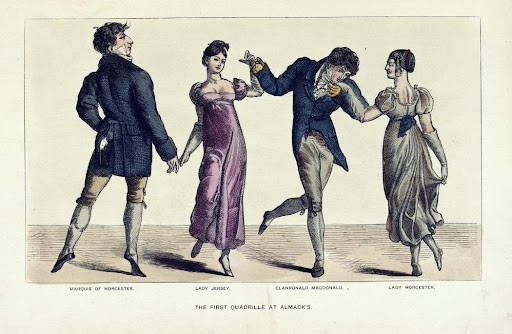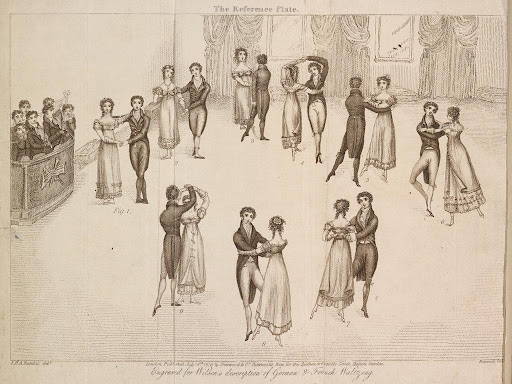Adelaide Magnolia Letter 4 – To See and Be Seen
Almack’s and the Waltz

The First Quadrille at Almack’s, 1892. From The Reminiscences and Reflections of Captain Gronow. Pub: J.C. Nimmo, London. Courtesy of the British Library.
Almack’s Assembly Rooms was the place to see and be seen during the height of the Regency London Season. It’s weekly balls, held every Wednesday night from April to July, were host to only the most exclusive of the Ton and where every aspiring debutante wished to be admitted. There they could gamble, partake of meager repasts, and dance.
Gaining admittance was not as simple as just showing up at the door. In order to gain permission to buy a voucher, or ticket, for the season, one had to gain approval from the Lady Patronesses of Almack’s who controlled the operation of the establishment. These patronesses were six to seven ladies from the top tier of society, from the most powerful families politically and socially. An Annual voucher, or ticket for entry, for the season could be purchased for ten guineas and it was non-transferable. Only the person it was issued to could use it, but the patronesses had the authority to revoke a voucher for a social faux pas or transgression which would then render the individual a social outcast. Subscribers could bring guests if they obtained approval for said guests from the patronesses and were given a “stranger’s ticket” of admission.
Once a voucher holder, your admittance to the rooms was not always guaranteed. There were strict rules that were enforced. For instance, men were required to wear breeches, stockings, waistcoats, evening coats and gloves. Ladies were required to be in Evening gowns and to wear long gloves. If your clothing did not meet the Patroness’ standards you were turned away at the door. You also had to be punctual. If you arrived after 11pm you could not gain admittance as the doors were closed to additional attendees.
But despite the strict rules of entry and admittance, Almack’s was still the place that everyone wanted to go. It was here that the real “marriage mart” of The Season was held, where young ladies could be introduced to society at large and eligible young men more specifically, outside of private balls and dinner parties. In fact, to some aspiring Mamas, having their daughters welcomed at Almack’s for their first season in London became more important than being presented to the queen.

A Couple Performing a Waltz, from Correct Method of German and French Waltzing, 1816. Wilson, Thomas. Courtesy of the British Library.
And of course, the main activity of Almack’s was dancing. In the early years of the 19th century the dances were limited to English country dances and Scottish reels. In these dances, though couples were partnered up, physical interaction was limited to holding of finger tips or hands as they moved among the other dances in a series of movements, sometimes switching partners as they performed figures. Needless to say, the contact between the ladies and the gentlemen was minimal.
This all changed with the introduction of the Waltz. The Waltz originated in Germany and Austria around 1750 as a couple’s dance of the lower classes, but by the later 18th century it had become popular in Vienna and then spread in popularity to other European countries. It is thought to have arrived in England in the early 1800’s, though the exact date is disputed among historians and sources, and made more popular around 1814 and 1815 with the end of the Napoleonic wars as diplomatic relationships in Europe resumed and State visits to England took place.
The Waltz created controversy in London society. It is a style of dance performed in the closed position with partners facing one another, requiring the dancers to be in an embrace-like hold, maintaining close proximity throughout the entire length of the dance. Many viewed this as improper, equating it to promiscuous and indecent behavior. Some mamas of young ladies in society would not permit their daughters to dance the Waltz. For these reasons, the waltz was banned from Almack’s until somewhere around the early 1810’s, the Patroness’ deemed it acceptable to be danced, but only with their express approval. If a young lady were to dance the waltz without first receiving approval from one of the Patronesses she would be relieved of her voucher and snubbed by society. But despite society’s misgivings, with time, the waltz rose in popularity and by the mid 19th century, it became the dance of choice in the ballrooms of London.
Learn the Vernacular:
Lud: exclamation of dismay or surprise
Quadrille: a dance consisting of 4 couples danced in a square in a 2/4 or 6/8 time signature
Lady’s Pass: ticket or voucher of entry
A Peer: a member of nobility holding the title of Duke/Duchess, Marquis/Marchioness, Earl/Countess, Viscount/Viscountess, Baron/Baroness, Baronet/Dame, or Knight/Dame
Russian Gold: another name for rose gold, which was very popular in the early 19th century for Russian made jewelry. It is an alloy of gold mixed with copper, making it stronger and giving it a rosy tint.
Call him out: to draw attention to someone’s questionable behavior, occasionally resulting in an altercation between the two parties
Admiralty: the administrative authority responsible for naval affairs, including the command of naval forces, shipbuilding, and maritime law enforcement.
Sources:
https://en.wikipedia.org/wiki/Almack%27s#The_Assembly_Rooms_at_King_Street
https://merrynallingham.com/regency-period/almacks-assembly-rooms/
https://janeaustensworld.com/2011/01/14/almacks-assembly-room-and-its-snobbish-patronesses/
https://branchcollective.org/?ps_articles=cheryl-a-wilson-the-arrival-of-the-waltz-in-england-1812
https://www.regencydances.org/paper013.php
https://en.wikipedia.org/wiki/Waltz
https://en.wikipedia.org/wiki/Regency_dance
